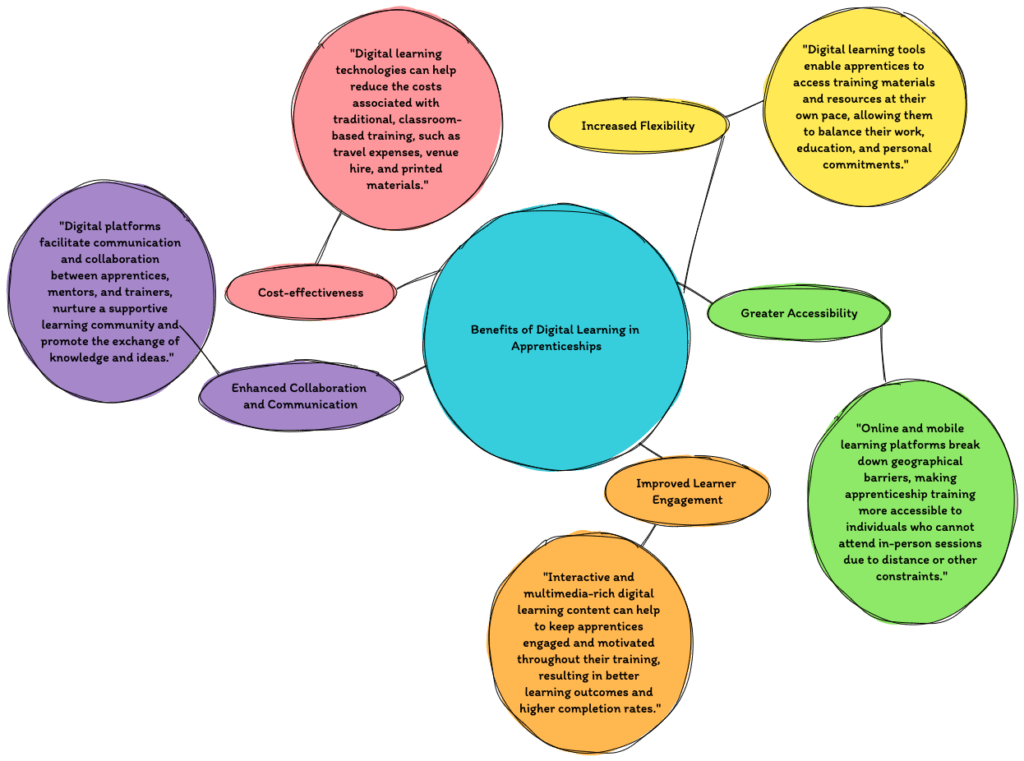Apprenticeships have long been a proven method for equipping individuals with the skills and knowledge needed to succeed in various industries. However, as the global economy and job market evolve, so must the way we approach apprenticeship programmes. One of the most significant developments in recent years has been integrating digital learning technologies into apprenticeship training, offering new opportunities for learners and employers.
In this article, we will explore the transformative impact of digital learning on the apprenticeship landscape, examining how technology is reshaping how apprenticeships are designed, delivered, and assessed. We will discuss the benefits and challenges of adopting digital learning approaches in apprenticeship programmes and future growth and innovation opportunities. Furthermore, we will provide best practices for integrating digital learning into apprenticeships and showcase successful case studies to inspire and inform readers.
By understanding the potential of digital learning in apprenticeships, employers, training providers, and other stakeholders can harness its power to create more effective, flexible, and accessible programmes, ultimately helping to drive the success of apprentices and the industries they serve.
The Evolution of Apprenticeships
Historically, apprenticeships have been centred around hands-on, on-the-job training, with apprentices learning directly from experienced professionals in their chosen fields. This time-tested model has produced countless skilled workers but has limitations. Some of the challenges associated with traditional apprenticeship models include the following:
- Limited flexibility: Traditional apprenticeships often require learners to attend in-person training sessions at fixed times and locations, which may not suit everyone’s schedule or personal circumstances.
- Inconsistent learning experiences: The quality of training can vary significantly between different employers and mentors, leading to inconsistent learning outcomes for apprentices.
- Difficulty keeping pace with rapidly changing industries: Traditional apprenticeship programmes can struggle to adapt to the ever-evolving workplace needs, particularly in sectors driven by rapid technological advancements.
The Evolution of Apprenticeships in Response to Changes in the Workplace and Technology
Over time, apprenticeships have evolved to address these limitations and better align with the changing nature of work and the growing influence of technology. Some key developments include:
- The introduction of formal education and training components: In addition to on-the-job training, apprenticeship standards now set out explicit knowledge, skills, and behavioural competencies that need to incorporate classroom-based learning or online coursework to provide a more structured and comprehensive educational experience.
- Emphasis on transferable skills: Apprenticeships are increasingly focused on developing a broader set of transferable skills, such as problem-solving, communication, and digital literacy, which are valuable across various industries.
- Integration of digital learning technologies: Adopting digital learning tools and platforms has enabled apprenticeship programmes to become more flexible, accessible, and efficient, allowing learners to access training materials and resources anytime, anywhere.
These adaptations have not only helped to address some of the limitations of the traditional apprenticeship model but have also created new opportunities for innovation and growth within the apprenticeship industry, paving the way for the further integration of digital learning technologies.
The Impact of Digital Learning on Apprenticeships
Digital Learning Technologies in Apprenticeship Programmes
Integrating digital learning technologies into apprenticeship programmes has revolutionised how training is delivered and consumed. Some of the most commonly used digital learning tools and platforms in apprenticeships include:
- E-learning platforms: These online learning management systems (LMS) enable the creation, delivery, and tracking of training content, allowing apprentices to access courses, quizzes, and other resources at their own pace and convenience.
- Virtual classrooms: Video conferencing tools and virtual classroom platforms facilitate real-time, interactive learning experiences, enabling apprentices to participate in live lectures, workshops, and discussions without being physically present.
- Mobile apps: Customised mobile applications can provide apprentices with on-demand access to training materials, job aids, and performance support tools, allowing them to learn and apply new skills directly in the workplace.
- Simulation and virtual reality (VR): These immersive technologies can create realistic training scenarios, allowing apprentices to practice complex tasks and develop hands-on skills in a safe, controlled environment.
Benefits of Digital Learning for Apprenticeships
The adoption of digital learning technologies in apprenticeship programmes has resulted in numerous benefits for learners, employers, and training providers, such as:
- Increased flexibility: Digital learning tools enable apprentices to access training materials and resources at their own pace, allowing them to balance their work, education, and personal commitments.
- Greater accessibility: Online and mobile learning platforms break down geographical barriers, making apprenticeship training more accessible to individuals who cannot attend in-person sessions due to distance or other constraints.
- Improved learner engagement: Interactive and multimedia-rich digital learning content can help to keep apprentices engaged and motivated throughout their training, resulting in better learning outcomes and higher completion rates.
- Enhanced collaboration and communication: Digital platforms facilitate communication and collaboration between apprentices, mentors, and trainers, nurture a supportive learning community and promote the exchange of knowledge and ideas.
- Cost-effectiveness: Digital learning technologies can help reduce the costs associated with traditional, classroom-based training, such as travel expenses, venue hire, and printed materials.
By harnessing the power of digital learning, apprenticeship programmes can deliver more effective, flexible, and engaging training experiences, ultimately contributing to the success of apprentices and the industries they serve.

Challenges and Opportunities in Digital Apprenticeships
Challenges in Implementing Digital Learning Technologies
While digital learning offers numerous benefits for apprenticeships, employers and training providers may face certain challenges in implementing these technologies. Some of the most common obstacles include:
- Resistance to change: Traditional apprenticeship models may be deeply ingrained in certain industries, and employers and employees might be hesitant to embrace new technologies and approaches to training.
- Technological infrastructure: Implementing digital learning technologies may require significant investments in hardware, software, and network infrastructure, which can be a barrier for smaller businesses or organisations with limited resources.
- Ensuring quality and compliance: As apprenticeship programmes move online, employers and training providers must ensure that the digital learning content and delivery methods meet industry standards and regulatory requirements and maintain the quality of learning experiences.
- Digital literacy and access: Not all apprentices may have the necessary digital skills or access to technology to participate in digital learning initiatives, potentially leading to disparities in learning opportunities and outcomes.
Opportunities for Growth and Innovation in the Apprenticeship Industry
Despite these challenges, integrating digital learning technologies in apprenticeships presents numerous opportunities for growth and innovation in the industry. Some areas with potential for further development include:
- Development of new learning technologies: The ongoing advancements in learning technologies, such as artificial intelligence, adaptive learning, and augmented reality, offer exciting possibilities for creating more personalised, immersive, and compelling apprenticeship learning experiences.
- Collaboration between stakeholders: By promoting partnerships between employers, training providers, technology companies, and other stakeholders, the apprenticeship industry can drive innovation and ensure that digital learning solutions are tailored to the specific needs of learners and industries.
- Data-driven decision-making: Digital learning platforms generate valuable data on learner performance, progress, and engagement, which can inform decision-making, identify areas for improvement, and ensure continuous quality enhancement in apprenticeship programmes.
- Expanding access to apprenticeships: Digital learning technologies can help to make apprenticeship opportunities more accessible and inclusive, reaching a broader and more diverse pool of talent and addressing skills gaps in various sectors.
By addressing the challenges associated with digital learning and capitalising on the opportunities for growth and innovation, the apprenticeship industry can continue to evolve and adapt to the changing needs of learners, employers, and the wider economy.
Best Practices for Integrating Digital Learning into Apprenticeships
Successfully integrating digital learning into apprenticeship programmes requires careful planning and execution. Here are some practical tips and recommendations for employers and training providers looking to incorporate digital learning into their apprenticeship programmes:
- Assess needs and objectives: Identify your apprenticeship programme’s learning needs and objectives, which will help inform your choice of digital learning technologies and strategies.
- Select appropriate technologies: Choose digital learning tools and platforms that align with your organisation’s needs, budget, and existing infrastructure. When selecting, consider factors such as ease of use, customisation options, and scalability.
- Align online and offline learning experiences: Ensure digital learning components are seamlessly integrated with traditional on-the-job training, creating a coherent and cohesive learning journey for apprentices. This may involve aligning learning objectives, coordinating schedules, and encouraging collaboration between online and offline trainers and mentors.
- Develop engaging and relevant content: Design digital learning content that is engaging, interactive, and relevant to the needs of your learners and industry. Use multimedia elements such as videos, animations, and quizzes to maintain learner interest and enhance knowledge retention.
- Provide adequate support for learners: Comprehensive support for apprentices navigating digital learning platforms and resources. This may include providing technical assistance, assigning mentors or learning coaches, and facilitating online discussion forums to encourage peer-to-peer learning and collaboration.
- Monitor and evaluate progress: Regularly track and assess learner progress using the data and analytics provided by digital learning platforms. Use this information to identify areas for improvement, provide targeted feedback, and ensure that learners are on track to achieve their learning goals.
- Encourage continuous improvement: Develop a culture of continuous improvement by regularly reviewing and updating digital learning content, technologies, and strategies based on learner feedback, industry developments, and emerging best practices.
By following these best practices, employers and training providers can create more effective, flexible, and engaging digital learning experiences within their apprenticeship programmes, ultimately contributing to the success of apprentices and the industries they serve.
Conclusion
In summary, integrating digital learning technologies is transforming the apprenticeship landscape, offering new opportunities to enhance the effectiveness, flexibility, and accessibility of training programmes. As explored in this article, adopting digital learning tools such as e-learning platforms, virtual classrooms, and mobile apps can lead to numerous benefits for apprentices, employers, and training providers, including improved learner engagement, cost-effectiveness, and better learning outcomes.
Despite the challenges associated with implementing digital learning technologies, there are also significant opportunities for growth and innovation in the apprenticeship industry. By addressing these challenges and embracing new learning technologies, stakeholders can help shape the future of apprenticeships and ensure that they remain relevant and responsive to the changing needs of learners and industries.
As you consider the future of your apprenticeship programmes, we encourage you to reflect on the potential benefits and opportunities that digital learning can offer. By adopting best practices for integrating digital learning and building collaboration between stakeholders, you can help drive the success of your apprentices and the industries they serve.



